I’m excited to have found my first Amanita on the property, but frustrated with my own inexperience with this genus. It’s made it a challenge to narrow down a more specific identification of this fungus in time for Mushroom Monday. However, it’s been a reminder that sometimes things are not always as they first seem, at least not in the world of fungi.
This fungus appeared after last week’s brief rain, growing under oaks and madrone on the western facing slope above the house. I saw it from at least 20 feet away, as its bright yellow cap stood out clearly among the brown leaves on the ground.
That it is an Amanita, I have little doubt. If the cap was red, I’d probably say its identification would be a slam dunk as the classic fly agaric, Amanita muscaria.
I’m presuming, based on some of the physical characteristics, that this is a yellow form of Amanita muscaria species, which are known to occur, but as to subspecies or variety, I can’t say conclusively. It’s possible it is Amanita muscaria var. formosa, but that variety is reportedly more common in eastern North America, than the west [1].
This specimen has some of the classic hallmarks of this group of agaric mushrooms, including a brightly colored cap, with warts, an annulus or skirt on the upper part of the stem, which was remarkably still intact, and scaly concentric shaggy ‘rings’ at the base of the swollen stipe.
Typical ofAmanita muscaria, this young specimen shows warts that are clearly yellow when young, but becoming white when exposed to sun. In the picture below, the more white colored warts were exposed to daylight, but the yellow warts toward the rear of the cap were still mostly under dirt and forest duff when I found this mushroom.
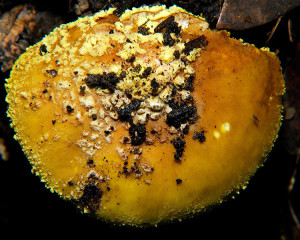
The warts of this species are very friable. Note the 'warts' in the front, that were exposed to light, are more white. Those in the back, that were still covered with leaf litter, are more distinctly yellow
An interesting characteristic of these warts is that they were remarkably fragile, and sloughed easily, a trait perhaps more common to Amanita gemmata according to some sources [2,3], but there seems to be some contention as to whether A. gemmata truly occurs here. Just to add to my confusion.
The fragile skirt, or annulus, on the stem was clearly still intact, and is the first mushroom I’ve found on the property with an intact annulus. The edge of the annulus was distinctly flecked yellow, similar to the warts on the cap.
Pulling away the dirt toward the base of the stem it was clear the stipe was yellowish in color, and below the annulus, distinct bands of remnant veil material toward the base of the stem were apparent.
Unlike some Amanita species, there was no distinct cup-shaped volva at the base of the stem.
Unfortunately this was the only specimen found on the entire hillside, and on my return the next day to re-photograph it, something had clearly come along, dug it up, and absconded with it. A skunk perhaps, who recently always seems to be one step ahead of me on the mushroom hunting front! Some Russula sp., and numerous Hygrocybes that I’ve been watching develop this winter, have similarly disappeared with nothing but holes and claw marks in the soil where they once were. Clearly this creature is not a fan of ‘Mushroom Mondays’.
Another yellow species that has been identified in California is Amanita aprica. This toxic yellow Amanita species tends toward a more frosted appearance over the yellow cap, with rather more flattened and adherent warts, than distinct fragile, and pointed ones. The overall cap color of A. aprica is similar to this specimen, but generally it seems the stem is more stout and robust than this fungus appeared to be. It would have been helpful if I’d found more than one, in various stages of maturity. However, after a lot of reading, and poring through mushroom keys and photographs, it’s clear that the next specimen I find needs to be examined more closely, likely even at the level of a microscope, for a definitive ID. So for now, our best educated guess is a yellow variant of Amanita muscaria.
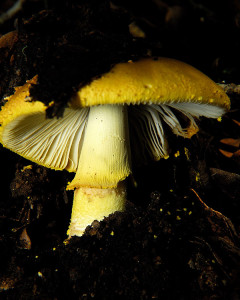
Amanita muscari? gemmata? aprica? Next time we'll take a specimen to some local experts for a definitive ID!
Note that we only hunt mushrooms with camera lenses here, but this genus deserves a significant amount of cautious respect from all mushroom hunters. Although some species of Amanita are edible, some of our deadliest mushrooms in this region also belong to this genus. Admittedly this yellow Amanita has little resemblance to our deadly Amanita phalloides (the Death Cap), or Amanita ocreata (the Destroying Angel), but it is very similar in color and form to Amanita aprica which is known to be toxic [4].
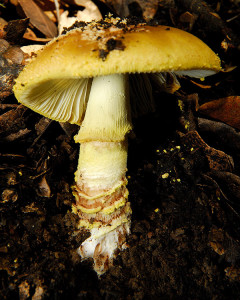
Regardless as to its true identity, this is one of the more beautiful species we've found on the property
As such, we leave our foraging for kitchen-bound mushrooms to the experts, and we strongly suggest you do too!
————————–
[1] Mushroomexpert.com Amanita muscari var. formosa
[2] Mushroomexpert.com Amanita gemmata
[3] McKnight, K.H and KcKnight V.B. 1987. Peterson’s Field Guides – Mushrooms. p. 225
[4] Tulloss, R.E. and Lindgren, J. E. 2005., Amanita aprica—a new toxic species from western North America. Mycotaxon 91: 192-205.


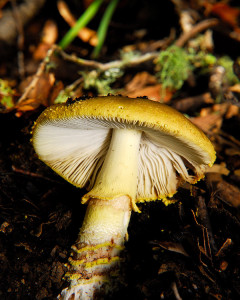



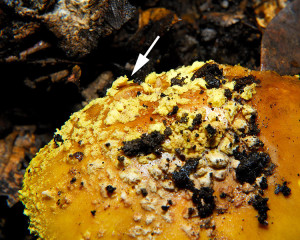
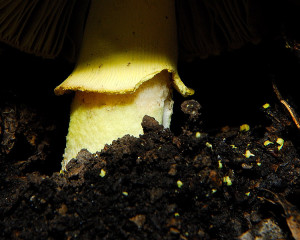








Hi! Congrats for finding all these lovely mushrooms. I have lots of varieties here but like you said, I’ll rather leave them to the experts to identify them. Different varieties can look very alike. I do not have the courage to consume any although I have read that the puff balls are edible.
We’re lucky, as some of our Farmer’s Markets carry some wild mushrooms that are edible. It’s much safer to buy from them, than to guess as to what’s growing here!
You answered my question: how can you be sure that a mushroom is edible. Very interesting. cheers. ann
Often, just by looking you can’t. I think most of the Amanita poisoning cases have probably been cases of mistaken identity. Without a microscope, and a few lab tests, even the experts can’t say for certain whether a mushroom is a toxic species or not. I’m not an expert…so I don’t forage 😉
The yellow sure is pretty. They almost don’t look real. Most mushrooms I’ve seen out in the wild are tan or brown, nothing this colorful.
There are many ‘little brown mushrooms’ (LBMs) here too Catherine, most of which I have no clue what they are. Some I can narrow down to genus, but most are just LBMs. That’s what makes these vibrantly colored mushrooms that much more interesting!
Your series is quite interesting. I am going to start paying more attention to the mushrooms in our region. I admire their variety,form and color. I am sure wild mushrooms would be quite tasty, but I plan on sticking with the ones from the grocery store. I am taken with your camera angles of them. Really good photos, so descriptive.
I find mushroom structures to be very beautiful in form, and love trying to photograph them, although it does usually result in some extra laundry when I’m done 😛
Amanitas are fun to find but make me go cross eyed when trying to identify them. I had to be satisfied with a multiple choice much like yours.
Amanita flaviconia and
Amanita muscaria var. Formosa
Amanita muscaria
EXACTLY! I’d choose (D) All of the above 😛
I am amazed at your beautiful mushroom photography, as well as your investigative abilities. And I find out another fact I did not know: Skunks eat mushrooms!
Well, I can’t say for certain, but the holes dug around where the mushrooms were are remarkably suspicious for skunks…although I have yet to catch one in person absconding with next week’s mushroom post! 😀
How interesting! Are you saying the mushroom is toxic to humans but not to skunks? I would have expected fellow-mammals would react similarly… But then again, there’s dogs and chocolate.
It’s certainly possible…however, we don’t know that the skunk (or whoever my mushroom thief is) didn’t crawl behind a large fir or oak and end up with a belly ache 😛 Animals can be more or less sensitive to a number of compounds though, just as some humans are more reactive to some drugs or toxins than others. We’ve certainly had a lot of sizable holes dug around here this winter, some of which are more obviously skunk damage, going after grubs, or ground dwelling bee nests. The mushrooms though, I can’t say for certain, but Pepe is my best guess.
Dear Clare, I always learn so much from your wonderfully informative postings. I have never seen or heard anything like your intriguing yellow mushroom that you feature here…but clearly something else finds it delicious……I should never be tempted to forage on my own…’death cap’ says it all!!
I agree, Death Cap, and Destroying Angel both hint significantly at their toxic nature! I’ll stick to shiitakes and oyster mushrooms 😉
That is one beauty of a fungus! Fascinating to hear of your skunk adventures!
It’s always something chomping its way from one end of the property to the other 😛
Fascinating, Clare. I’m asking myself the same question as Town Mouse. I’ll be interested to read your response.
We have a range of Amanitas here, from a fawn-brownish-yellow through to apricot and on into soft orange, but they mostly pop up in the fall. I never saw one with such easily detachable warts before, which makes me think A. gemmata more likely (assuming it even occurs where you live, haha.)
We did find one white one on a mountain hike which we were told by an expert was a Death Cap (apparently a foreign species introduced here from Europe), so you are right to warn us!
When I read about the friable warts on A. gemmata for a brief second I thought ‘that’s it!’. Some that are more expert than me do refer to some gemmata-like Amanitas here on the west coast, I’m just not sure the genus has all been worked out, at least not at the genetic level.
We apparently have a brown species of Amanita that’s more common here too, although I haven’t yet seen it for myself. Amanita pantherina, which apparently looks like a brown A. gemmata. Toxic, but supposedly not deadly. It’s amazing how much range there is in toxicity in this genus of mushrooms!
They are beautiful and I will probably always forage for my mushrooms at the grocery store! It’s too bad the clever skunk runs off with prize fungi, but, maybe it’s best he’s one step ahead! gail
I’ve been thwarted a number of times on the fungus front by my mushroom bandit this winter. Some mushrooms look so different depending on which stage of growth you see them in, so I like to try and capture them at different stages. It’s easier with clustering fungi species, but the loners like this specimen, when there’s only one, you have to hope something doesn’t run off with it before your next photo! 😛
This series should be a book, Clare. You are a gem with an obvious love for fungus … keep them comin’ !
Hi Clare! I always love your mushrooms, and you provide such an education! I have some of those red capped shrooms. It’s funny how I’m disgusted and intrigued by these fungi…all at the same time! Great post!
Honestly, for safety, being disgusted is a good thing. I know a few culinary avante guarde mushroom hunters, that quite honesty, scare the…spores out of me!
As always, I love these mushroom posts and great pics. I’ve seen the more characteristic red Amanita muscaria quite often in the East Bay hills these last two years. They’re so distinct and always beautiful to see. And it looks like your yellow was a prime specimen before being dragged off.
‘Twas a fantastic young specimen, before my mushroom thief dragged it off! I’m more familiar with the red specimens too…but apparently our mushroom chomper isn’t terribly concerned with an accurate ID before dinner! I actually have yet to spy a red specimen of this genus here. They may be here, I just haven’t caught them here…yet.
Very informative, Clare. Hooray for wild mushrooms! I love seeing them, would love, love, love to be able to cook my own wild ones. Why aren’t mushrooms experts more mainstream? I can imagine a foraging outing with lots of advice for finding safe to eat ones,…but where?
Oh! Do you have Arora’s Mushrooms Demystified book yet? That should probably help you positively ID the mushrooms you come across.